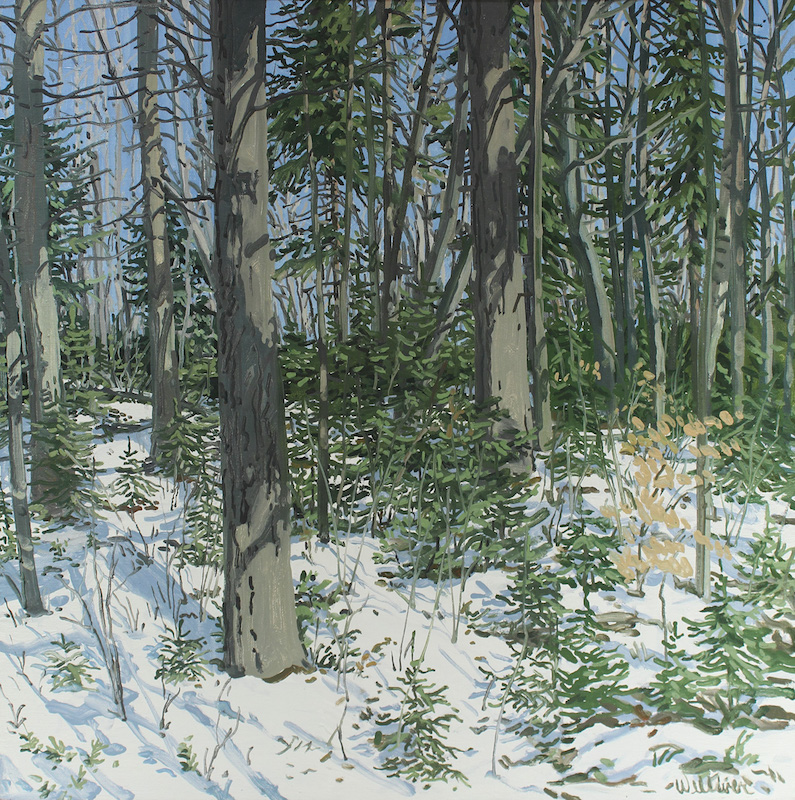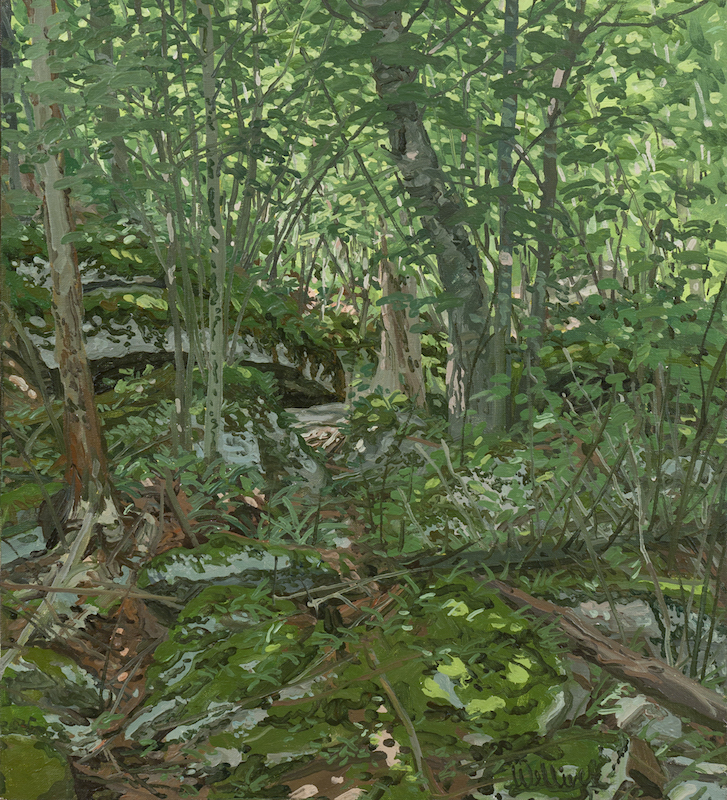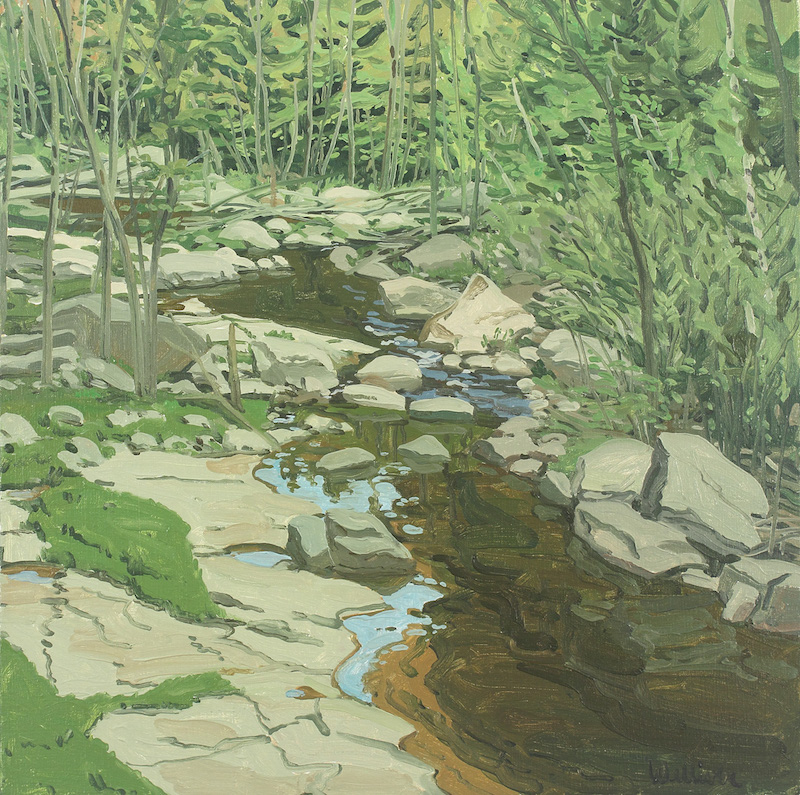
©Neil Welliver, courtesy Alexandre Gallery, New York.
“Painting outside in winter,” Neil Welliver once said, “is not a macho thing to do. It’s more difficult than that. To paint outside in the winter is painful. It hurts your hands, it hurts your feet, it hurts your ears. Painting is difficult. The paint is rigid, it’s stiff, it doesn’t move easily. But sometimes there are things you want and that’s the only way you get them.” In order to get the things he wanted, Welliver ventured outside in all seasons to paint on the expanse of wooded property he owned in Lincolnville, Maine (see Study for Little Spruce). One suspects that the onerous winter storms that have recently beset the Northeast wouldn’t have much slowed him.
A sampling of Welliver’s intrepidness is on view at Alexandre Gallery in the Fuller Building, in the form of ten works, mostly oils, painted directly from nature on small square canvases. Many of these were studies for the large canvases Welliver later worked up in his studio. Welliver’s mature landscapes are essays on nature viewed in solitude, yet his approach is not that of a painstaking naturalism: there’s a bounce to his white clouds and snow covered rocks, which could be mistaken for dollops of fresh whipping cream. This whiff of Pop modernism, strongest in his 1970s paintings of nudes shivering in ponds, is sublimated to an immersion in the complex shapes of the landscape. Welliver was delighted by oscillating pattern and the tangle of forest undergrowth, the busier the better (see Study for Prospect).

©Neil Welliver, courtesy Alexandre Gallery, New York.
According to Welliver, his color was not meant to be imitative. “I never try to get the color I’m looking at. I never copy the color I see. NEVER.” His palette, devoid of earth tones, was chosen to suggest the presence of air and to create an image that would parallel, rather than replicate, the luminosity of nature. The light in Welliver’s painting is cool, clear and bracing. “I was looking at something extremely obscure,” he once explained, “not light in the normal sense, light bathing objects, but light in the air, flashing and moving like a flow of energy through space. That interests me greatly. That’s what my paintings are about.” This is a very different conception from that of say, Homer, Hopper, or Wyeth, each of whom saw the Maine light as a vehicle for the revelation of solid form.
Small wonder, given that Welliver’s influences were elsewhere, and included Josef Albers, Pollock, and Mondrian. His paint application is consistently, if creamily, flat, so that the sensual excitement in his canvases is often provided by graphic shapes and color fluctuation. The acknowledgment of artifice in terms of color as well as in his affinity for flatness—he was ever distancing himself from comparisons to the illusionary space of nineteenth-century Hudson River School painting—was as central to Welliver’s art as was his connection to Maine’s topography. This apparent dichotomy runs through the work of several of our best contemporary landscape painters, including Rackstraw Downes and Sylvia Plimack Mangold, who, like Welliver, are as concerned with how we see as what is being seen. All came out of a Yale School of Art that was largely antipathetic to traditional representational art.
Welliver dealt with the complexities of his subjects methodically—it continues to surprise me that major artists are given to the most banal routines, but his were especially systematic. In the studio he always started his large canvases in the upper left-hand corner, proceeded downward and diagonally, and once having reached the lower right-hand corner, never went back to make corrections. His unfinished paintings confirm another methodical practice: every shape was circumscribed in pencil before color was added, the very model of the paint-by-number process.

©Neil Welliver, courtesy Alexandre Gallery, New York.
The studies are skillfully painted, though without overtly performative flair; Welliver was taking comprehensive notes and saving the panache for his studio pieces. The illustrative impact of Welliver’s big paintings—it’s possible that I first saw his work on the cover of an L.L. Bean catalogue—used to turn me off. What I’ve come to admire is an improbable reconciliation, that the “Pop-ness” of his pictures is grounded in the certainty that they represent a personal communion with the Maine landscape. In fact, one sometimes misses the amped-up colors of the big paintings when surveying the restraint of the studies.
And sometimes not. Study for Spring Brook preserves the intimacy of the artist’s response, with an atmospheric subtlety that Welliver sacrificed in the finished eight-foot canvas (not in show), where value and color are pushed beyond credibility, and the mechanisms of his studio process are conspicuous. In the study, complex shapes are held together with masterful drawing, and the fluid manipulation of pigment echoes the oily, curling arabesques of the stream’s reflections.
For all Welliver’s interest in the surface plane of the canvas and his love of formal structure, he was determined to paint pictures that a viewer could enter, particularly, in his words, in a “psychological sense. If there’s any doubt that he was working in a three-dimensional mode, compare a Welliver landscape to one by Klimt. No matter. Welliver’s thoughts on art are compelling, but they pale in comparison to the paintings themselves, which are among the most beautiful and evocative landscapes of our time.
Neil Welliver Oil Studies and Selected Prints and Selected Works by Gallery Artists are on view at Alexandre Gallery at 41 East 57th Street until February 21.




